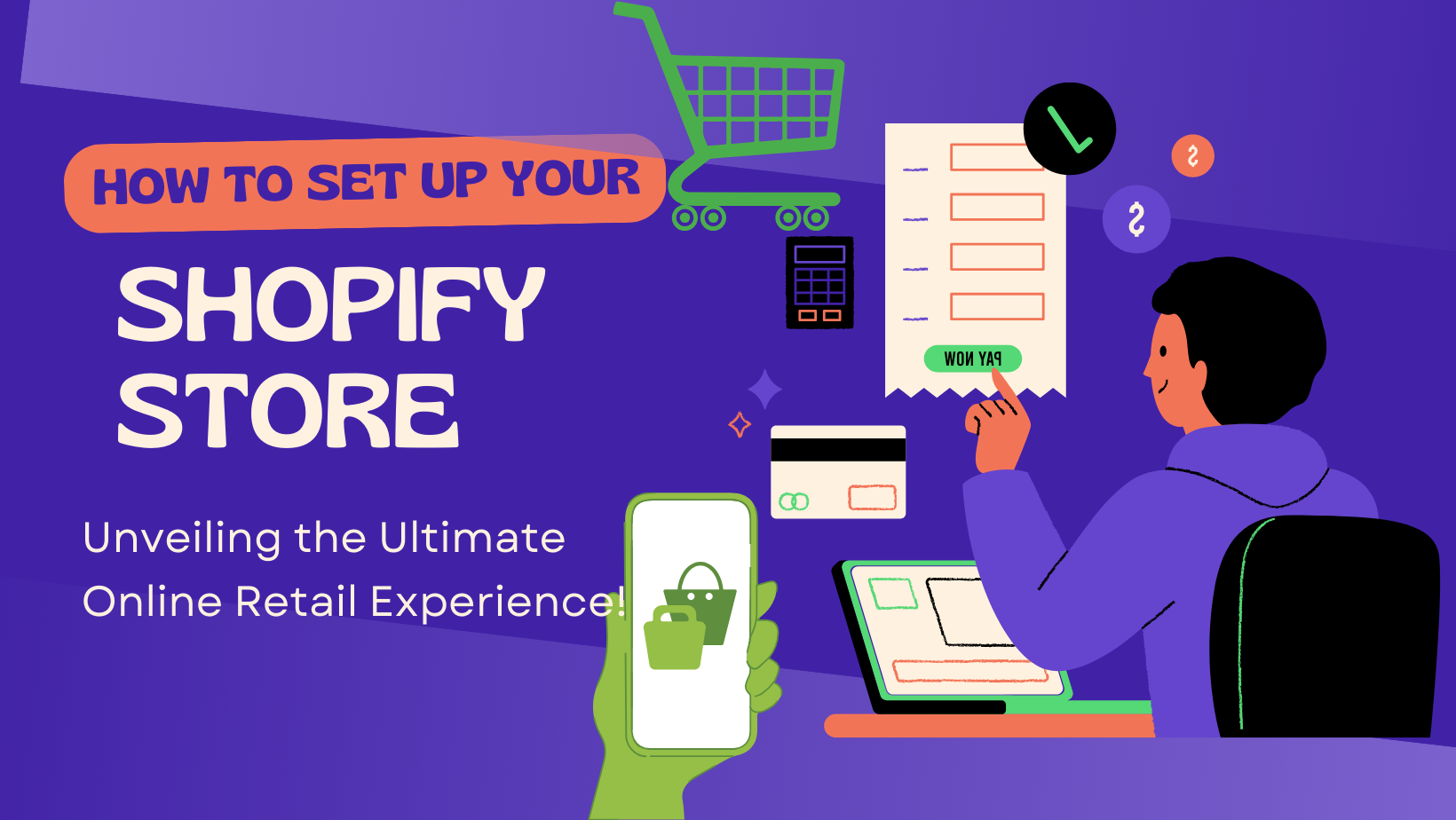
Learning how to set up your Shopify store requires no prior technical knowledge; all you need is the suitable guidance. Starting a business online has never been easier than it is right now.
Using tools like Shopify means you do not need to be tech-savvy when starting an e-commerce site.
Anyone who wants to start selling handcrafted goods, digital products, or online commodities through drop shipping will find Shopify’s flexible and easy-to-use platform perfect. There are the steps to set up your Shopify store.
This thorough video will guide you through the 10 simple, easily attainable steps required in setting up your Shopify store.
Why should you use Shopify?
Let us first review the reasons Shopify is the best choice before we begin the setup process:
- Thousands of apps for marketing, payments, and automation
- SSL certification and dependable hosting included
- Always there when you need help
- User-Friendly Interface without any coding knowledge
- Mobile Optimizing responsive designs across devices
Let us now walk over the ten simple steps you must follow to open and start selling your Shopify business.
Step 1: The initial action is registering on Shopify

Make Your Own Free Trial Practicable
Go to Shopify.com and choose the “Start Free Trial” choice.
You will be contacted to:
- Put your email address on the given field
- Create a password then choose a name for your online store
Your store name will be turned into your Shopify subdomain (for example, “yourstorename.myshopify.com”), even though you will be able to link a custom domain at a later time. This is the first step in set up your shopify store.
Respond to the Basic Questions
After that, Shopify will ask some questions about your business to find out more:
- Are you selling anything here?
- Are you just starting or do you already show presence in sales?
These let Shopify tailors your dashboard to fit your particular needs.
Step 2: Customizing the parameters of your store
Share Information About Your Business
After navigating to the Settings menu, choose General then complete the following:
- The store’s name
- The legal firm’s name
- The email address
- The phone number
- The address
Bills will also show this information, as will several correspondence to clients. This is the second step in set up your shopify store.
Set the Time Zone and the Currency
Choose the time zone and currency you wish to use for your store under the same settings.
This will help your checkout and reports to be consistent.
Step 3: Choosing and personalizing your theme comes last
Choose a Shopify Theme to Purchase
Visit the “Online Store” and choose “Themes” from among the free or premium themes. Shopify offers as follows:
- Simple, complex, and fit for beginners are free themes
- Conversely, paid themes present more intricate elements and unique designs
Choose a color scheme that accentuates the brand of your business and its product range. This is the third step in set up your shopify store.
Make Your Theme’s Appearance Unique
Click the “Customize” button to start the Shopify Theme Editor. You can: from this place
- Upload the symbol of your company
- Change the fonts and the colors
- Arrange banners on the homepage
- Create highlighted collections
- Establish the menus for traversing
Make sure the design is compatible with cell devices and easy for use.
Step 4: Add Your Products

Click Products > Add Product under Menu.
Verify that every product has the following filled out:
- Title
- Description (use language suitable to search engine optimization)
- Images (high-quality images)
- Pricing
- SKU or barcode
- Inventory tracking
- Shipping details
Variations in size, color, or style are also available to you. This is the fourth step in set up your Shopify store.
Create Product Collections: Arrangement
Your products are arranged according to groups, including the following:
- New arrivals
- Best sellers
- Sale products
- Seasonal collections
- And more comprise featured items
Open the Products menu and chose Collections to build and oversee collections.
Step 5: Setting your domain name comes
Shopify’s Domain Name Purchase
One could buy a domain name from Shopify straight away via the Settings > Domains option.
It makes an automatic link to your company.
Make Use of a Third Party’s Domain
Already have a domain name? Compile it using:
- Ensuring your registrar is current with DNS settings
- Adding it to Shopify from the Domains > Connect existing domain part
Having a branded domain raises professionalism and trust as well. This is the five step in set up your shopify store.
Step 6: Creating payment gateways
Online Accept Payment Method
Visit Settings > Payments to choose among a range of options.
There are:
- Shopify Payments
- PayPal
- Stripe
- Amazon Pay
- Hand payment techniques (such as bank deposit requests)
Most people choose Shopify Payments.
Using Shopify Payments lets you utilize big credit cards without paying any fees from a third party. This is the sixth step in set up your shopify store.
Sort the Payroll Schedule
Choose if daily, weekly, or monthly prizes would be most suited for you.
Step 7: Configuring the Shipping Settings
Establishing Shipping Zones
See the Settings menu and choose Shipping & Delivery to complete the following:
- Specify shipping zones including the United States, Europe, and Asia
- Add tariffs including flat rates, free shipping, and weight-based pricing
- If applicable, schedule local delivery or pickup
Work with Transportation Providers
Apps or Shopify integrations will let you link with carriers like:
- FedEx
- DHL
- USPS
- UPS
You may simply print shipping labels when viewing your dashboard. This is the seventh step in set up your shopify store.
Step 8: Establishing taxes and legal pages
Program Taxes Automatically
By visiting the Settings > Taxes menu, Shopify can automatically calculate sales taxes depending on your region and the area of your consumers.
Please consult a tax specialist if you are unsure about the legal responsibilities relevant in your country.
Add Pages for Legal Matters
Under Settings > Legal, include the following important policies:
- One document covers terms of service
- Refund policy
- Privacy policy
- Shipping policy
Apart from fulfilling legal requirements, these boost client confidence and support legal development. This is the eighth step in set up your shopify store.
Step 9: Create the required applications
The Shopify App Store features thousands of tools meant to improve your store. The following is a must-have:
Search Engine Optimization and Marketing
- Optimize meta tags and content
- Privy or Klaviyo—email marketing automation
- SEO Manager—Enhance your search result position
Conversion and User Experience
- ReConvert Upsell is an after-sale offer
- Wishlist Plus lets consumers bookmark their favorites
- The website Judge.me offers ratings and reviews on products
Analytics
- Google Analytics integration
- Lucky Orange or Hotjar for heatmap and visitor behavior understanding tool
Choose just the apps you really need to avoid slowing down your shop. This is the nineth step in set up your shopify store.
Step 10: Open and advertise your store.
Review and Validate All Ahead
Just before launching:
- Check that every connection is in working order
- Check your checkout system
- View your website in desktop and mobile versions
- Look over the product photos and descriptions
Abolition of Password Protection
Deactivating the password security by visiting the Online Store > Preferences menu will help your store to be open to the general public. This is the tenth step in set up your shopify store.
The Starting of Your Store’s Marketing
Following some of the most effective techniques can help you attract your initial customers:
Marketing on Social Media Sites
Social media channels including Instagram, TikHub, Pinterest, and Facebook will help you show your goods.
Email Marketing
You should send launch emails to your connections and give early clients discounts.
Content Marketing
Create a blog on Shopify using subjects relevant to your company to attract search engine optimization activity.
Paid Advertising
Google Ads or Meta Ads let one target certain groups and boost visibility.
Extra Advice to Enable You Grow Your Company Following Set up your Shopify Store
Your journey does not stop once your store is open.
Here is how to proceed for additional business scaling: These are the steps to set up your Shopify store.
Track Record of Performance Using Analytics
Use:
- Shopify reports
- Google Analytics
- Facebook Pixel
To grasp the following:
- Customer behavior
- Traffic sources
- Products most sold
- Conversion rates
Based on Your Comments, Optimize
Review consumer comments and make any required changes to the products, pricing, or website design.
Stress Retention
Keep your present customer pleasure by:
- Customized newsletters
- Special promotions
- Loyalty programs
- Exclusive offers
- Personalizing letters
Maintain Your Store Current Going Forward
New items, seasonal collections, or site remodeling will help you to keep freshness.
Some Last Comments
Following these ten simple guidelines will help you create a perfectly beautiful online store in addition to a completely functional one.
From choosing a theme to marketing your brand, every action you do is bringing you closer to running a profitable e-commerce company. These are the steps to set up your Shopify store.
Shopify allows entrepreneurs all around to turn their ideas into a consistent revenue source.
Whether you are launching your first product or expanding an already-existing company, the present moment is the perfect opportunity to jump in. These are the steps to set up your Shopify store.
Want to know about “Understanding Google Analytics: Best Beginner’s Guide.“

